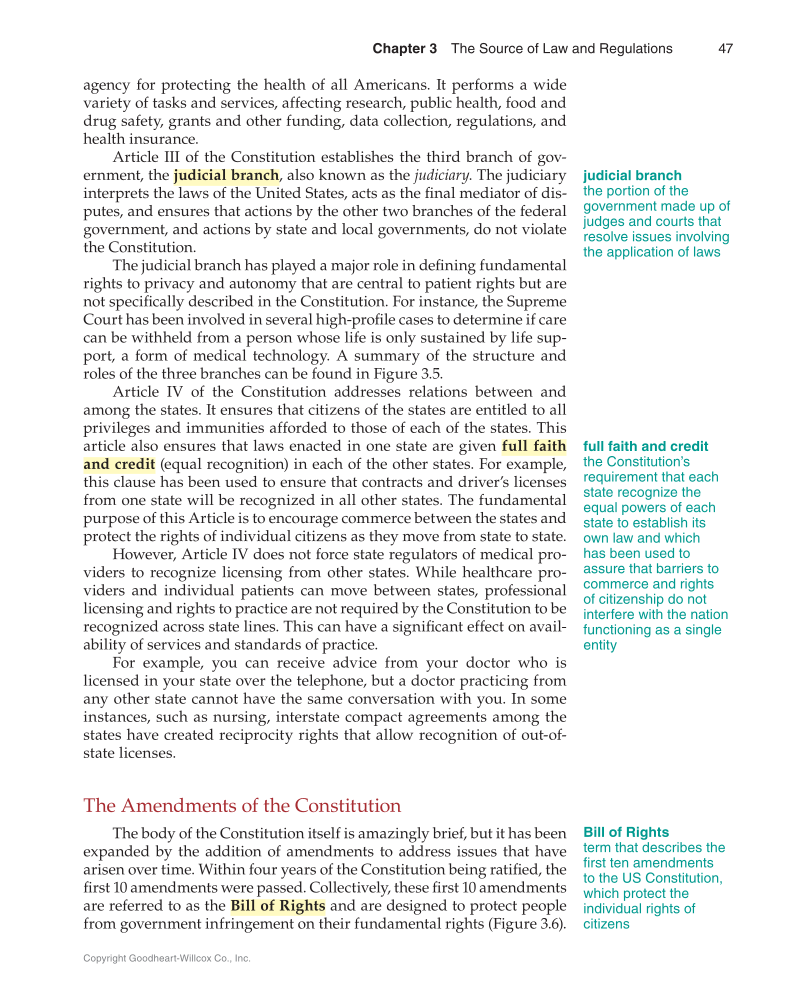Chapter 3 The Source of Law and Regulations 47 Copyright Goodheart-Willcox Co., Inc. agency for protecting the health of all Americans. It performs a wide variety of tasks and services, affecting research, public health, food and drug safety, grants and other funding, data collection, regulations, and health insurance. Article III of the Constitution establishes the third branch of gov- ernment, the judicial branch, also known as the judiciary. The judiciary interprets the laws of the United States, acts as the final mediator of dis- putes, and ensures that actions by the other two branches of the federal government, and actions by state and local governments, do not violate the Constitution. The judicial branch has played a major role in defining fundamental rights to privacy and autonomy that are central to patient rights but are not specifically described in the Constitution. For instance, the Supreme Court has been involved in several high-profile cases to determine if care can be withheld from a person whose life is only sustained by life sup- port, a form of medical technology. A summary of the structure and roles of the three branches can be found in Figure 3.5. Article IV of the Constitution addresses relations between and among the states. It ensures that citizens of the states are entitled to all privileges and immunities afforded to those of each of the states. This article also ensures that laws enacted in one state are given full faith and credit (equal recognition) in each of the other states. For example, this clause has been used to ensure that contracts and driver’s licenses from one state will be recognized in all other states. The fundamental purpose of this Article is to encourage commerce between the states and protect the rights of individual citizens as they move from state to state. However, Article IV does not force state regulators of medical pro- viders to recognize licensing from other states. While healthcare pro- viders and individual patients can move between states, professional licensing and rights to practice are not required by the Constitution to be recognized across state lines. This can have a significant effect on avail- ability of services and standards of practice. For example, you can receive advice from your doctor who is licensed in your state over the telephone, but a doctor practicing from any other state cannot have the same conversation with you. In some instances, such as nursing, interstate compact agreements among the states have created reciprocity rights that allow recognition of out-of- state licenses. The Amendments of the Constitution The body of the Constitution itself is amazingly brief, but it has been expanded by the addition of amendments to address issues that have arisen over time. Within four years of the Constitution being ratified, the first 10 amendments were passed. Collectively, these first 10 amendments are referred to as the Bill of Rights and are designed to protect people from government infringement on their fundamental rights (Figure 3.6). judicial branch the portion of the government made up of judges and courts that resolve issues involving the application of laws full faith and credit the Constitution’s requirement that each state recognize the equal powers of each state to establish its own law and which has been used to assure that barriers to commerce and rights of citizenship do not interfere with the nation functioning as a single entity Bill of Rights term that describes the first ten amendments to the US Constitution, which protect the individual rights of citizens
